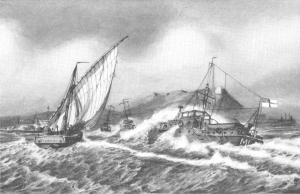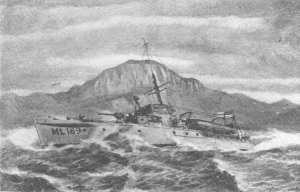In addition to excerpts and information drawn from this book elsewhere in these pages it is useful to quote two larger blocks of text directly from Nutting's book. These quotes give some insight into the thinking about the Motor Launch among the men who served aboard them and gives an idea of some of the types of duty to which they were assigned.
It was to be expected that there would be some criticism of such a type of boat when it arrived on the other side. Not only were the naval authorities unfamiliar with this sort of craft, being somewhat behind our own navy in experience with motor-driven boats, but the yachtsmen of the R.N.V.R., who for the most part commanded them, were equally inexperienced in the type. The Britisher had a constitutional leaning toward a model with greater draft for sea work and a pretty good leaning it is too, and there was not a little apprehension that the boats would behave badly and might actually capsize in a heavy sea. The motor they knew to some extent and besides, its sturdy, honest qualities were just those to appeal to the conservative British temperament.
Gradually whatever doubt there may have been at the start was dispelled by the remarkable performance of the boats. When they arrived the submarine shifted the scene of his activities farther and farther out to sea and the ML's gradually came to be called upon to perform much more strenuous work than anyone had anticipated when they were designed. For days on end they maintained their station far out at sea-too far to be able to run for a harbor in case of dirty weather. Frequently they were forced to ride out storms which for cussedness and perseverance have our own brand beaten forty ways. The shallow North Sea is bad enough at any time, but in the winter it is downright wicked.
But the ML's made good. Not only in the actual work of patrolling for submarines but in countless other ways as well - sweeping for mines in the channels ahead of ships, convoying merchant vessels, towing the deadly Q type paravane for lurking subs, laying mines, co-operating with air craft - in the Channel, in the North Sea, in the Mediterranean, at the Dardanelles and in the Adriatic.
In this connection it might be interesting to read what the skipper of one of the ML's has to say about them. "Seven Pennant," writing in the Yachting Monthly, says
"Our sympathetic friends and relations on shore have often expressed pity for the hardships of the winter of wet and cold, but no one outside the ML's themselves have ever realized what is really the greatest hardship of all. It is summed up in the word motion. Reader, have you ever tried to do a continual course of Swedish exercises from, say, 4 a. m. until 6 p. m. with no interval for food? I take it you have not, but if you can try and imagine to yourself the bodily fatigue and vexation of spirit that would be produced by this form of penance and then add to it wind, bitter cold and, perhaps, nay probably, wet, you may glean some idea of the hardships expressed by this little two syllabled word. I might also have added a slight form of nausea common to many of us, but often not admitted. Motion - and we get it throughout most days of the winter - is the curse of our existence. It is present without respite, without pity for fatigue and aching bone and muscle, an enemy to rest, to rob us of food, and indeed of every amenity of life. This briefly is what the hardships of motion mean to us. An ML is never on an even keel, save on the very smoothest of days, days that during the year one can count on one hand. We ride over everything, and our very lives depend on this fact, for we are too fragile to "go through" or take it really "solid." It is due to this fact, too, that our brave little ships derive their wonderful seagoing capacity.
"In spite of all we hear to the contrary, how wonderful are the sea-going qualities of the ML's. Never in my wildest dreams did I think a small vessel of their size could live in the seas I have seen them live in, and survive without the smallest hurt, the only anxiety being the engines, the failure of which might have meant disaster, and perhaps death. The longer I live and have my being in them the more I marvel at the boats and the more confidence I gain. How different it has turned out to that which I was led to expect in those early days of the service when we were all "doing" our ML course at one of the bases. Speaking personally those were the days of expectant cold feet, and so much did I hear of the unseaworthiness and general futility of these little craft, that I dreaded the day when I should have to set out on one. Even our instructors used to inform us that with a following sea in the Solent it had been found impossible to steer an ML, and that they had even tried towing 30 fathoms of a 4-inch rope astern, but apparently without avail. Then we heard a vessel had blown up going round the coast and that the crew had perished miserably in the flames as the burning petrol surrounded them as they swam. This and like harrowing tales were bandied round, but, looking back after this considerable lapse of time, I am inclined to think it was part ignorance and partly a case of bad workmen blaming their tools. * * * * *
We ML sailors are specialists. We do things and go out in weather that no sailor, accustomed to ordinary ships, would in his prudent senses attempt unless he had served with understanding in our ships. Some of the most fundamental axioms of seamanship we put aside. Do not the more knowing ones among us invariably clear from a crowded harbor quayside in a tideway by going astern? Provided she is handled astern and not ahead, in the hands of the artist the ML can be made to `do anything except wait at table,' but who taught the knowing ones this now quite obvious principle but that most excellent of all teachers, practical experience? And indeed it is this teacher that has taught us most of what we know. We have had to find our own way along a thorny path for the most part, with no one to advise us, and at first generally under the orders of someone who, through no fault of his own, had no more idea of what we could do than the man in the moon-in those days we had very little idea ourselves."
The Cinderellas of the Fleet
A DANGEROUS GAME
We are indebted to Lieut. Morris P. Shea, RNVR, for many interesting facts about the work of the ML's. During the last eight months of the war, Lieut. Shea was in command of one of the ML's working with the British Grand Fleet at Scapa Flow in the Orkney Islands. His work, with that of the other ML's, consisted of patrolling, convoying, running torpedoes for the ships of the fleet and in fact almost any sort of a job which was beneath the dignity of the larger vessels. One of the motor launches was tied for several days to a pier operating its auxiliary engine, furnishing electric light for an air station on one of the islands and also furnishing current for a movie show to entertain the sailors of the Grand Fleet. For a considerable time Shea's ML was stationed in a little bay outside the entrance to Scapa Flow harbor where the British fleet, as well as some of the American battleships, lay at anchor. It was expected that sooner or later the Germans would endeavor to break through the nets at the entrance to this harbor. The risk was great but the stakes were high. In order to be prepared for such a raid, the ML's were kept at five minutes' notice for weeks on end and were ordered to sea at any hour of the day or night - sometimes because suspicious craft were heard by the hydrophone listening stations on shore and at other times merely to keep them on the jump and prepared for the real thing.
An interesting stunt and a dangerous one in which Shea participated was pulled off shortly before the armistice was signed. A signal came for his ML No. - to remain at anchor at a given point within shelter of a certain island and to carry out a prearranged program at eleven o'clock that evening. It was pitch dark. The orders were to proceed at full speed without lights and make for the entrance to Scapa Flow. It must be remembered that the war was very much on at this particular time and this was exactly what it was expected that some daring unterseeboot might attempt at any moment. His job then was to play submarine and endeavor to get as far as the boom without being noticed - scarcely an enviable position at a time when your friends are likely to shoot first and investigate afterward.
The islands round about were equipped with powerful searchlights with watching crews to look for and locate instantly any suspicious craft that might attempt to enter the prohibited area. Any such craft would also be heard by the hydrophone listening stations.
The orders were to proceed at full speed and not to stop until picked up by the searchlights or fired upon. This he did, zigzagging, stopping, going full speed astern, in order to elude the searching fingers of light that seemed every instant to be on the point of exposing him. Finally a blinding shaft picked up the ML and in scarcely a second's time it was the center of two score powerful beams like a brilliant gem in some weird, titanic stage setting. Then when the watchers discovered that they had not bagged a German, the lights went out and the ML returned to an extra late supper.
Such things as those were all in the day's work of the ML and many a time the similarity that these little craft bore to a submarine on the surface, accentuated by fog, darkness or the fevered imaginations of some high-strung gun crew, drew the fire of their own countrymen - and a brief line in the obituary column.

